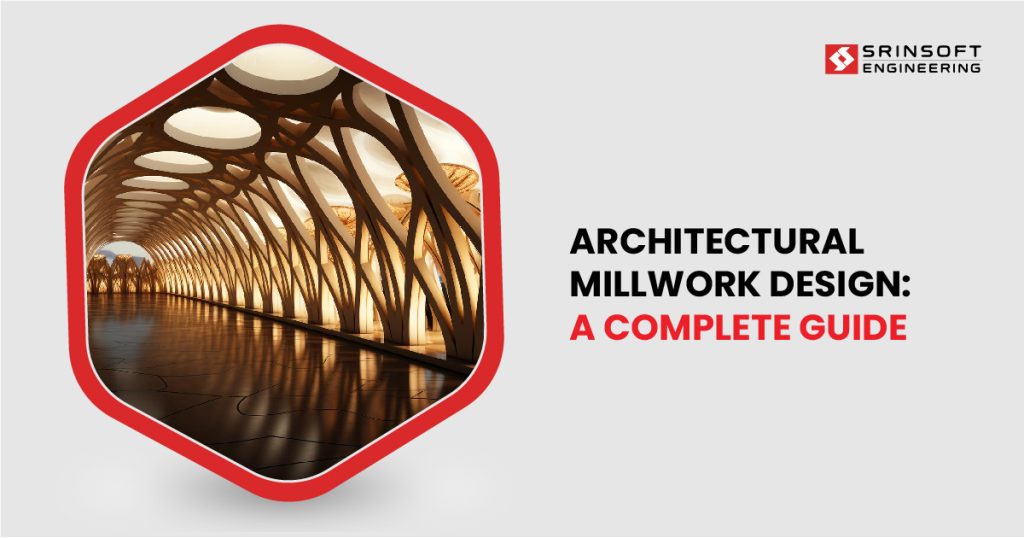
Architectural millwork design serves one of the most important functions of improving the aesthetic appeal of a space as well as its function. Millwork includes custom woodwork features such as cabinetry, moldings, paneling and trim that can be seen in residential, commercial or institutional applications.
These elements elevate interiors, imparting character, elegance and craftsmanship without sacrificing the functionality of the woodwork. Millwork is a staple of architecture that demands a balance of artistry and structural ingenuity that creates a seamless transition between wall, ceiling, and floor.
As construction projects have grown increasingly complex, so has the demand for precision-engineered millwork. Millwork specialists work closely with architects and designers to ensure each project fulfills the design vision and functional needs.
Of all components of a building, architectural millwork is truly an aspect that integrates construction with aesthetics, thus anyone in the industry must understand millwork design to some degree as it will impact both the operational and visual aspects of any building.
What is Millwork?
Millwork is a generic term used for any woodwork which is manufactured or custom-made and is used in the interiors and exteriors of building constructions. It includes all aspects from doors, window casings and moldings to staircases, cabinetry and decorative trim.
Unlike general carpentry where woodwork elements are built or assembled on-site by carpenters, millwork is fabricated at special factories before being installed on site.
Millwork components are manufactured with precision to deliver consistent performance and high-end finishes, so they are one of the most widely used products for enhancement of architecture.
When advanced woodworking machinery and materials are utilized, millwork can meet design specifications while satisfying functional needs.
What is Architectural Millwork Design?
Architectural millwork design refers to the process of designing and creating detailed plans for custom wooden elements used in a structure and its interior. This encompasses the design of moldings, paneling, shelving units, custom furniture, and other decorative elements.
Architectural millwork integrates with the building’s design and can reflect the architectural style of the building. Selection of material, dimension, detailing for strength, performance and visual harmony are part of the designing stage.
Millwork designers today use CAD software to create accurate blueprints that serve as a guide during fabrication. The detailing that architectural millwork designs impart makes spaces more visually engaging and turn otherwise ordinary spaces into character-filled environments that have richer and more intricate finishes and carved details.
Role of Architectural Millwork Design in Construction Projects
Architectural millwork design for construction projects is a critical part of integrating aesthetic design with structural integrity. It provides decorative and functional woodwork elements while staying consistent with the project’s theme and elevating interiors.
Millwork is also a big part of elevating the overall atmosphere — whether in swirls of detailed ceiling beams, grand staircases or elaborate custom-built cabinetry. In addition to aesthetics, millwork adds practicality to a space by optimizing storage, enhancing acoustics and defining areas within open-plan designs.
Collaborating with architects, designers and millwork manufacturers, each piece is custom crafted to fit perfectly within the construction ultimately strengthening the quality of the structure and aesthetics of the woodwork.
Different Types of Millwork Manufacturers
Millwork manufacturers play an important role in construction by supplying woodwork elements that are custom made for architectural purposes.
Helping architects and builders understand the types of millwork manufacturers is therefore crucial as it will allow them to opt for an appropriate millwork manufacturer depending on their project size, budget or the complexity of design.
Depending on the project, there are three main types of millwork manufacturers:
1️⃣ Custom Millwork Manufactures
Custom millwork manufacturers build bespoke pieces, according to a design specification. They collaborate with designers and clients, creating original, custom-cut woodwork that adds personalization to projects.
2️⃣ Standard Millwork Manufactures
Standard millwork manufacturers typically mass produce wood components such as doors, moldings, and cabinets. These manufacturers are responsible for the cost efficiency and consistency and make them suitable for building large scale dwellings.
3️⃣ Hybrid Millwork Manufacturers
Hybrid millwork manufacturers seek to capitalize on both custom and standard products capabilities with semi-custom offerings that find the sweet spot between personalization and pricing.
Types of Millwork Services in the Architectural Industry
Millwork services are an extensive part of the architectural industry. They work on specialized processes that are used in preparing high-quality woodwork elements.
All these services are used for their benefits of precision, durability and attractiveness and are important for any commercial or residential construction project. Here are some of the major millwork services in the architectural industry
✅ Design Services
Design services consist of devising and mapping out detailed plans that direct manufacturing. Millwork designers rely on CAD software to produce detailed plans and specifications to meet both architectural and decorative requirements.
✅ Fabrication Services
Fabricate services cut, shape and assemble wood components using state-of-the-art CNC machinery and handcrafting techniques. Skilled artisans then use a range of materials to create bespoke or mass-produced millwork features with precision.
✅ Finishing Services
Finishing services focus on enhancing wood surfaces with laminates, veneers, stains, paints, and sealants to achieve the desired look and durability. Finishing protects the millwork from day-to-day wear and elements of the environment while improving the overall design scheme.
✅ Installation Services
This service helps in the accurate placement of millwork components into the building. Each piece is installed on-site by professionals, ensuring that millwork is properly integrated, stable, and built to last.
✅ Restoration and Repair Services
Restoration and repair services are offered for historical buildings, which helps preserve the intricate woodwork while enhancing its durability. These services include refinishing, repairing, or replicating millwork elements to preserve architectural heritage.
Uses of Architectural Millwork
From the healthcare industry to office spaces, architectural millwork can be found in many sectors to beautify and improve functional attributes. For residential applications, millwork can be found in kitchen cabinets, decorative moldings, and built-in furniture.
In commercial spaces, reception desks, workstations, wall paneling, and shelving are all areas where millwork is used to create a professional and inviting environment. Custom millwork elements like bar counters and display units are quite common in hospitality and retail design to impart sophistication and brand identity.
Durable millwork solutions for storage, seating, and functional workspaces serve healthcare and educational institutions. No matter the setting, architectural millwork plays an important role in a space’s aesthetic harmony, utility, and long-term value.
Explore: How Architectural Millwork Design Transforms Spaces
Materials Used in Millwork
Millwork can be made with different materials, each with its own unique properties. Solid wood — like oak, maple and mahogany — is a traditional choice due to its durability and natural beauty.
Products designed for durability such as engineered wood products like MDF (Medium Density Fiberboard) and plywood are more affordable and versatile than traditional wood. Both MDF and plywood are often veneered to give them an appearance similar to that of solid wood and reduce loss of material.
Thermally modified wood is essentially a more durable variant of naturally occurring wood since it is heat-treated and has better moisture and temperature resistance making it desirable in humid areas.
In modern millwork, sustainable materials such as reclaimed wood and bamboo are being more commonly utilized for their eco-friendly properties. Material selection is typically based on durability, aesthetic considerations, and budget, among other factors.
Conclusion
Architectural millwork design is a core component of any construction that combines aesthetics with utility. Whether it is to define interior spaces or provide intricate details, millwork is instrumental in establishing architectural integrity and functional purpose in a building.
Knowing different types of millwork manufacturers, services, and materials helps architects and builders decide what’s best for their projects. Utilizing well-thought-out millwork will allow the construction professionals to produce lasting and aesthetic spaces that are sure to be timeless.


